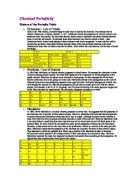Mendeleev’s prediction was close to what is known about gallium and therefore supports what he thought about the Periodic Table. The modern Periodic Table is based largely on what Mendeleev drafted, however, it is now complete with noble gases having been discovered, and furthermore the elements are now ordered by increasing atomic number opposed to relative atomic mass. (1+2)
Gallium is considered an unusual element as it has physical and chemical properties that suggest it could be either metal or non-metal. The first physical property suggests that gallium is non-metal because of its low melting point. Although mercury has a lower boiling point than gallium, mercury has stronger properties suggesting it is a metal. One explanation for the low melting point of gallium is because of the Ga2 molecules in the liquid. Gallium also has an extremely high boiling point of 2403ºC; this suggests that it is metal as most metals have high thermo-stability. The third physical property is that it is denser when liquid than when solid at its boiling point; it shares this property with water meaning it will solidify from the top down. The first chemical property which makes gallium a
(378 words)
confusing element is it is increasingly similar to aluminium, although this is expected
because Mendeleev called it eka-aluminium. Gallium dissolves in acid and alkalis developing hydrogen, the equations represent reactions of both elements with hydrogen ions and consequently show the similarity between their properties.
2Al(s) + 6H+ (aq) 2Al3+ (aq) + 3H2 (g)
2Ga(s) + 6H+ (aq) 2Ga3+ (aq) + 3H2 (g)
The only difference in the above equations is the symbols for the elements. Below are two equations showing that the elements respond the same in other chemical reactions.
2Al(s) + 2OH- (aq) + 6H2O (l) 2[Al(OH)4]- (aq) + 3H2(g)
2Ga(s) + 2OH- (aq) + 6H2O (l) 2[Ga(OH)4]- (aq) + 3H2(g)
The reaction stated above is between the elements in discussion and hydroxide ions, again the only difference is the symbol for the element. So far the chemical properties that have been discussed suggest that gallium is a metal as they are identical to the properties of aluminium. (1+7)
Atomic spectroscopy has been used successfully to detect the existence of unknown elements. An atomic emission spectrometer is used to stimulate atoms using an electric arc causing the atoms to absorb energy. The excited atoms emit light waves that can be split by a prism to show an emission spectrum. Below is a diagram of how the emission spectrum for hydrogen is formed.
The emission spectrum of hydrogen
How the Lyman series in the emission spectrum
is related to energy levels in the H atom
The Lyman Series relates to the first principal quantum shell where radiation emitted
(195 words)
appears in the ultra-violet range of the spectrum (1015). The second principal quantum shell is the Balmer Series, the radiation emitted in this shell is in the visible range of the spectrum (1014), the third shell is the Paschen Series, and this emits radiation in the infra-red range of the spectrum (1013). The radiation is emitted when electrons fall to a lower energy level. The lines on the bottom of the Lyman Series represent the electrons dropping from levels 1 to 5. This then produces a picture of the spectrum as shown below.
A diagram to show the colours of the emitted
radiation in the Lyman Series
The use of atomic spectroscopy increases knowledge regarding elements in the periodic table and so displays the energy types emitted and where the atom is being emitted from. (1+3+5)
The UNILAC accelerator fires a beam of heavy ions from an accelerator towards a heavy and stable element, this demonstrates that processes with violence defeat the expected repulsion of nuclei and thus ions fuse together, generating a new element. This picture shows an example of a UNILAC accelerator target which was fired at to produce new elements.
During a successful experiment with the UNILAC a beam of zinc ions were fired at a target of lead. The equation below shows the creation of Element 112.
30Zn + 82Pb 112Element
The picture below represents a 3D map of the known isotopes. The white columns
(220 words)
show stable nuclei found naturally. The orange network represents the radioactive isotopes that undergo β-decay. The yellow on the map denotes isotopes that undergo spontaneous fission, whilst the red area demonstrates α-decay. The small red column at the bottom of the map shows element 112.
A three dimensional map of the known isotopes
Despite successes with the UNILAC accelerator it became increasingly harder to produce atoms of new elements. (2+4)
Two hundred years ago it was the intention of scientists to discover new elements, today the focus of research is to synthesise new elements. There are only 92 naturally occurring elements, hydrogen to uranium; however the periodic table shows 106. A reason for this difference is because of modern apparatus and theoretical research. The increase in theoretical research extends the knowledge of scientists providing a clear idea of the formation of atoms and elements. This information has meant they have been able to put their knowledge into practice, testing their ideas and techniques. Providing their research is sound then they may be able to create the conditions and environment required to produce new elements. (2+6)
(175 words)
References
-
Article 1- Gallium: a landmark in the history of chemistry. (Adapted from an article by Gordon Woods, Chemistry Review, 2001, Volume 11, Number 2.
-
Article 2- The New Alchemists. (Adapted from an article by Robert Matthews, Chemistry Review, 1999, Volume 9, Number 1.)
- Skills for Chemistry Colour Insert 2. Article 1. Fig. 4 gallium spectrum from Spektrus.
- Skills for Chemistry Colour Insert 2 Article 2 Fig. 3 and © Science Photo Library.
- Salters Advanced Chemistry, Chemical Ideas 6.1 Light and Electrons pg 96-97
- Salters Advanced Chemistry, Chemical Ideas 11.1 Periodicity pg 191
- www.chemistry.allinfoabout.com/periodic/ga.html








